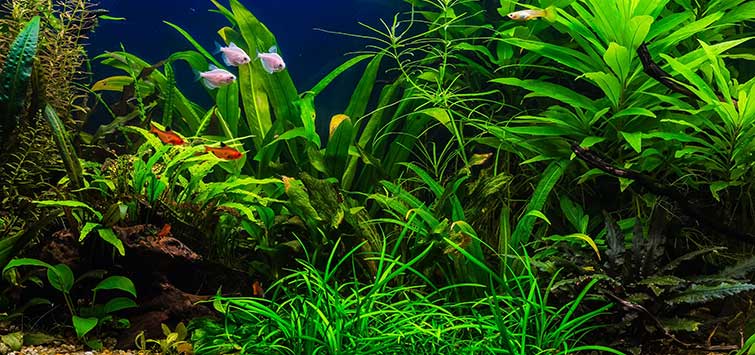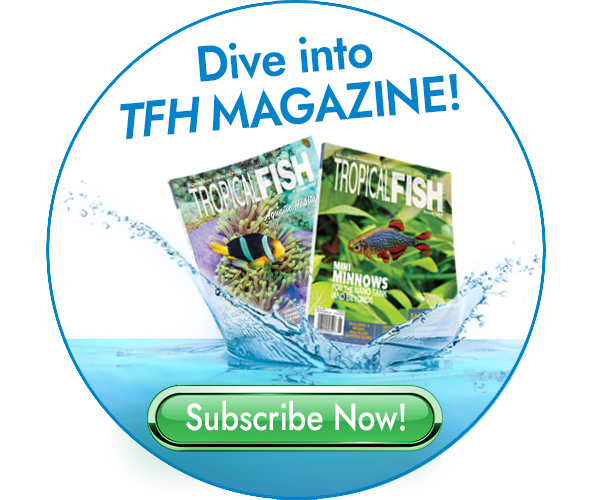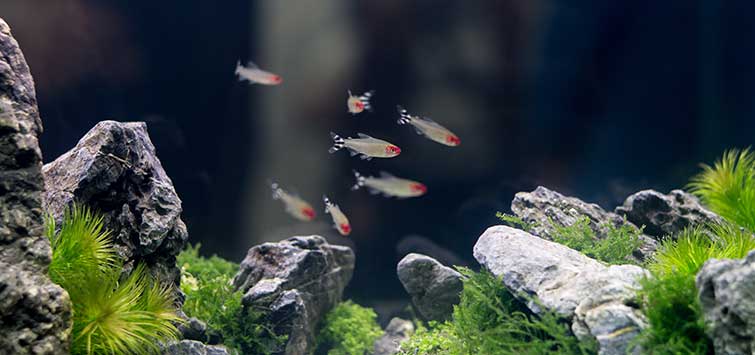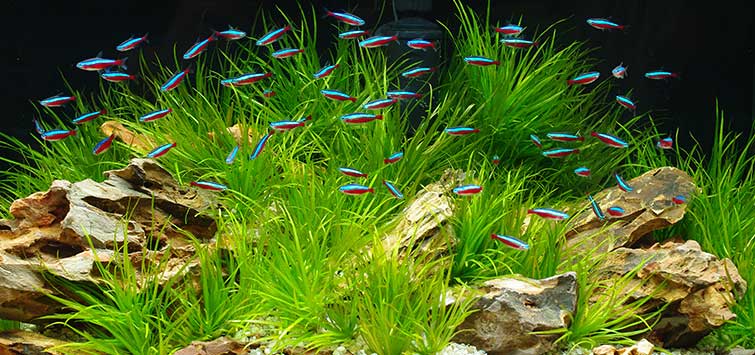Creating a Natural Feel by Combining Undergrowth Plants
Author: Takashi Amano
The aquascaping master describes how several species of short plants can be incorporated in the Nature Aquarium layout to convey the impression of vast, open space.
Purpose of Undergrowth Plants
In the Nature Aquarium, short aquatic plants that are commonly planted in the foreground of a layout or throughout an iwagumi layout are called undergrowth plants. Undergrowth refers to low-growing vegetation beneath trees in a forest. In the Nature Aquarium, the term is used as a generic name for short aquatic plants, in contrast to the tall aquatic plants (such as stem plants) that are used in the background.
Undergrowth is indispensable for rendering a natural feel and expressing a sense of depth in a layout in the Nature Aquarium. Even in a layout with cosmetic sand in the foreground, undergrowth, such as Riccia, willow moss, and Glossostigma, is often used in the area that connects the midground and cosmetic sand. A hierarchical structure, like what is often seen among plants in nature, can be expressed by using plants that are shorter than those planted in the background and midground. Therefore, aquatic plants that are used for undergrowth need to stay short not only when they are just planted, but also when they are grown to maturity.
Glossostigma
Glossostigma is a good example of a typical aquatic plant that can satisfy these conditions. The growth form of Glossostigma is ideal for undergrowth. It spreads sideways in a good environment by sending out many runners. On the other hand, stem plants are not suitable as undergrowth because their stems grow upward and they will eventually become too tall, even if they are cut short initially.
Glossostigma sends out runners and develops leaves to cover the substrate. The thickness of the plant will increase with runners and leaves, stacking and forming a mat. Hair grass, cobra grass, European clover, and Echinodorus tenellus also grow in a similar manner with runners, and they are often used as undergrowth as well. Additionally, Cuba pearl grass can be used as undergrowth, although it tends to grow horizontally by developing stems instead of runners.
Bryophytes that are typically wrapped on driftwood, such as Riccia and willow moss, can be used as undergrowth depending on the preparation method. In the case of using Riccia and willow moss as undergrowth, they should be wrapped on a flat stone with nylon string and placed on the substrate.
Giving an Iwagumi a Natural Feel
In the iwagumi layout introduced in this article, a natural feel is rendered by combining these undergrowth plants. In a typical iwagumi layout, only one undergrowth plant is used, and this has the effect of making the iwagumi appear larger.
Looking at a long shot of vast grassland in a photograph or a video, one cannot discern the type of grass growing there, and the field looks like it is composed of a single type of grass. Similarly, an iwagumi that is planted with a single type of undergrowth has an impression of a vast field. If you stand in a grassy field and look at the nearby grass, you will see that the field is made up of many types of plants. Those that are near you will appear large, and those that are farther away will appear smaller.
Plant Arrangement
The arrangement of plants in the aquascape in this article expresses this condition. Echinodorus tenellus is planted around the iwagumi, while different plants are planted in the front and the back of the iwagumi. The planting in the area in front of the iwagumi is composed of Glossostigma, Riccia, and hair grass. Hair grass is planted in three areas near the left and right ends, and the center of the aquarium. The other area is planted with Glossostigma and Riccia. Riccia is wrapped on small, flat stones and placed on the substrate, and Glossostigma is planted in between the stones. Both hair grass and Glossostigma grow by sending out runners, and their boundary becomes obscured. Riccia and the runners of Glossostigma intertwine and produce a sense of unity.
Cuba Pearl Grass
On the other hand, the area behind the iwagumi is composed of Cuba pearl grass alone. Cuba pearl grass is an undergrowth plant that has very small leaves. Its size difference with the other aquatic plants planted in the front renders a sense of depth by contrast.
A pot of Cuba pearl grass is typically divided into small bunches and planted with tweezers. However, it takes a long time for Cuba pearl grass to root in the substrate, and the small bunches of plants tend to come loose with buoyancy before they can develop roots. They often perish before rooting this way. Therefore, several groups of Cuba pearl grass that have been grown emersed in a plant-based medium are placed on the substrate in this layout. While Cuba pearl grass grows slowly underwater and takes time to develop roots, Cuba pearl grass that has been grown this way starts growing more rapidly when used in a layout because it has already rooted well.
All the undergrowth plants that are used in this layout, including Cuba pearl grass, can be trimmed by cutting a thin layer off the surface with scissors in the very same manner as trimming a single type of plant. I recommend that you give them a try, since combining undergrowth plants offers limitless possibilities.
Data
Aquarium: Cube Garden W180 x D60 x H60 cm
Lighting: (NAG-150W-Green) x 3 units, turned on for 10 hours per day
Filter: Super Jet Filter ES-2400 (Bio Rio L, NA Carbon)
Substrate: Aqua Soil Amazonia, Power Sand Special L, Bacter 100, Clear Super, Penac W/for Aquarium, Penac P, Tourmaline BC
CO2: Pollen Glass Beetle 50, 6 bubbles per second via CO2 Beetle Counter (using Tower)
Aeration: For 14 hours after the light is turned off using Lily Pipe P-6
Additives: Brighty K, Green Brighty STEP2
Water Change: 1/3 once a week
Water Quality: Temperature 25ºC (77ºF), pH 6.8, TH 20 mg/l
Aquatic Plants: Hemianthus callitrichoides “Cuba,”Echinodorus tenellus, Eleocharis acicularis, Glossostigma elatinoides, Riccia fluitans
Fish/Invertebrates: Paracheirodon axelrodi, Otocinclus sp., Caridina japonica
See the full article on TFH Digital http://www.tfhdigital.com/tfh/201105#pg55

.png?h=595&iar=0&w=2781&hash=5FD5E69473BCC22199FBFA2FB71B6033)



